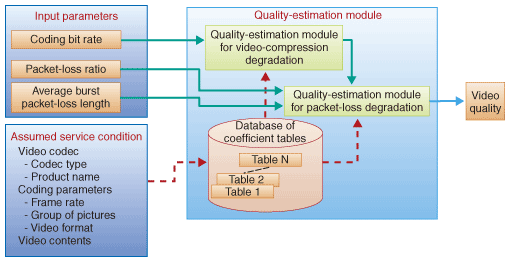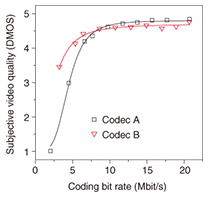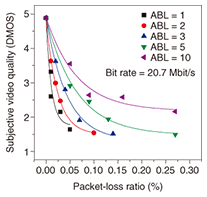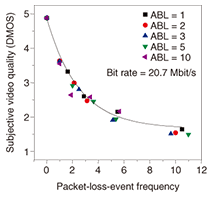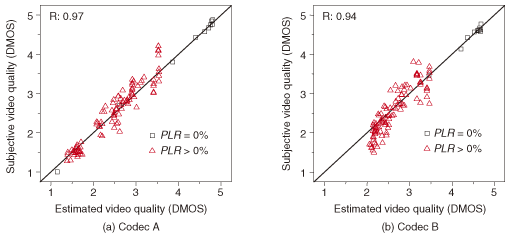 |
|||||||||||||||||||
|
|
|||||||||||||||||||
|
Special Feature: Quality of Experience (QoE) Design and Management for Audiovisual Communication Services Vol. 7, No. 4, pp. 27–31, Apr. 2009. https://doi.org/10.53829/ntr200904sf4 Planning Model for Audiovisual Communication ServicesAbstractThis article describes a computational model for quality planning of audiovisual communication services. The model estimates the quality of experience based on quality-design parameters for applications, networks, and clients rather than captured media signals and IP packets. In a subjective test, we verified that the quality-estimation accuracy was sufficient for practical use.
1. Quality planningAdvances in broadband IP (Internet protocol) networks and codecs (encoders and decoders) have enabled Internet service providers to provide audiovisual communication services (e.g., IPTV (Internet protocol television) and videophone services). The quality of experience (QoE) of audiovisual communication services is affected by four factors: 1) what kinds of features (e.g., fast/slow motion) the content has, 2) how the content is encoded and packetized before transmission, 3) what the characteristics of networks carrying the IP packets are, and 4) how packets are decoded and displayed at the client (e.g., set-top box or mobile phone). Therefore, for high-quality services, the designs of the coding parameters (e.g., coding bit rate) and networks are important. To enable audiovisual communication services to be designed easily and effectively before a service is offered, it would be desirable to have objective quality assessment models [1] that can estimate the QoE of audiovisual communication services. This article describes a planning model for only IPTV services. A planning model for videophone services is explained in references [2]–[4]. This article focuses on the video quality planning of IPTV services, although we have also developed a model for audio quality. 2. Framework of planning model for IPTV servicesPlanning models formulate relationships among quality-design parameters (application, network, and client parameters) and QoE, so they are very useful in QoE planning. These models should estimate quality using quality parameters rather than using captured media signals and IP packets. Thus, they can be used to efficiently design applications, networks, and clients before a service is offered. The framework of a planning model for IPTV services is shown in Fig. 1. The input parameters of the model are video-quality parameters. As the output, we propose that the planning model should estimate the QoE averaged over assumed sets of content because prior to the start of a service, we cannot know what kind of content will be watched by users.
The mathematical equations of the planning model should be developed from the following subjective video quality*1 characteristics. The video quality characteristics for different types of codec are shown in Fig. 2. This figure suggests that the video quality depends on the implementation (e.g., motion detection and rate distortion algorithms) of the codec because the degrees of degradation of these curves differ from one codec to another. In addition, the quality of a video codec and terminal cannot be estimated simply on the basis of information about the coding and terminal technologies. However, the qualitative tendency (video quality decreases with decreasing coding bit rate) of video-quality degradation does not depend on the codec implementation. Therefore, the mathematical equations (e.g., logistic and exponential functions) of the planning model are unified, and the model”Ēs coefficients are optimized for an assumed service condition (e.g., codec type (H.264 or MPEG-2), coding parameters (frame rate and video format), client (set-top box or mobile phone), and contents). That is, this model is composed of two quality-estimation modules (quality-estimation module for video-compression degradation and quality-estimation module for packet-loss degradation) and a database of coefficient tables, as shown in Fig. 1.
3. Planning model for IPTV servicesThis section describes two quality-estimation modules that are based on the subjective video quality characteristics shown in Figs. 3 to 5. 1) Quality-estimation module for video-compression degradation Subjective video quality increases and saturates with increasing coding bit rate, as shown in Fig. 3. Therefore, this module takes the coding bit rate as input and estimates video quality (Vqc) by using a logistic function. 2) Quality-estimation module for packet-loss degradation Subjective video quality decreases with increasing packet-loss ratio (PLR), and the degree of degradation of each curve differs according to the average burst packet-loss length (ABL)*2, as shown in Fig. 4. However, subjective video quality decreases with increasing packet-loss-event frequency (PLF)*3, so all the curves have the same degree of degradation, as shown in Fig. 5 [5]. Moreover, PLF is expressed by the value of PLR ÷ ABL. Therefore, Vqc, PLR, and ABL are input into this module to estimate the video quality affected by video compression and packet loss (Vq).
4. Quality-estimation accuracyTo validate the effectiveness of our model in terms of quality-estimation accuracy, we performed a test using two different types of H.264 codecs. These two encoders had different implementations. One decoder (codec A) without packet-loss concealment generated block noise when packet loss occurred. The other (codec B) had packet-loss concealment that generated freeze frames when packet loss occurred. Subjects assessed video qualities that were affected by video compression and packet loss. The planning model estimated the video qualities of each codec by changing the model”Ēs coefficients, which were optimized for each assumed service condition (e.g., codec, coding parameters, and video contents). The relationship between subjective video quality and estimated video quality is shown in Fig. 6, which also shows the values of Pearson-correlation coefficient (R). The estimated video quality correlates very well with the subjective video quality for each codec. Therefore, our model is applicable to the estimation of video quality degraded by video compression and packet loss.
5. Application, network, and client designIn this section, we describe an example of quality design for an application, a network, and a client to provide high-QoE IPTV services. Example parameters are shown in Fig. 7.
First, the QoE planner sets a quality requirement, e.g., DMOS ≥ 3.5. Second, the application is designed on the basis of the coding bit rate. For example, the codec”Ēs coding bit rate (Fig. 3) must be more than 6 Mbit/s to achieve the required QoE. Third, the network and client are designed by taking into account the packets lost by the network, discarded by the client, and recovered by an error correction scheme such as forward error correction. For example, when the coding bit rate is 20.7 Mbit/s, the PLF must be less than 2 to achieve the required QoE. When the ABLs are 1 (i.e., random packet loss) and 10, the PLRs must be less than 0.01% and 0.05%, respectively. 6. Conclusion and future activitiesTo contribute to better QoE planning, we devised a planning model that accurately estimates video quality affected by video compression and packet loss. Our model can take into account video quality characteristics for video compression and packet loss. We believe that this model provides reliable information about how users actually feel about the QoE of IPTV services and that it can be used for effective application, network, and client design. Our research group has proposed the model described in this article to ITU-T SG12 (International Telecommunication Union, Telecommunication Standardization Sector, Study Group 12), and we are continuing to improve the model. References
|
|||||||||||||||||||








